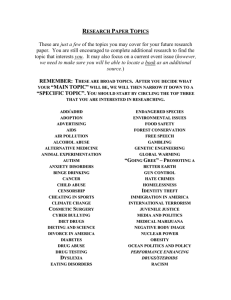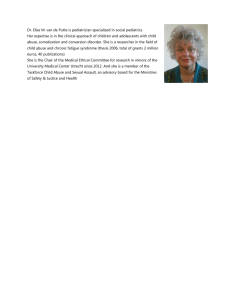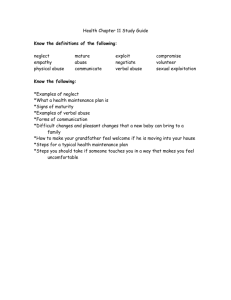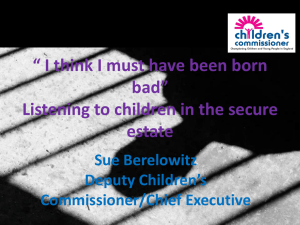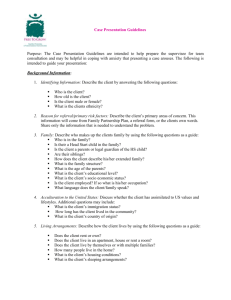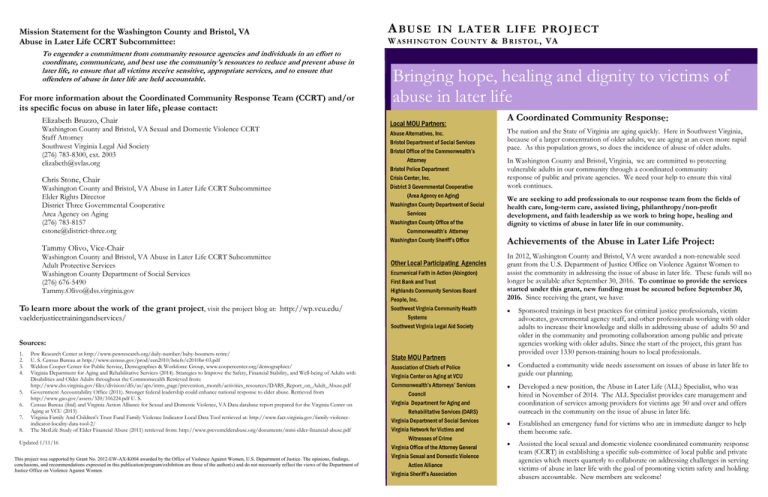
Mission Statement for the Washington County and Bristol, VA
Abuse in Later Life CCRT Subcommittee:
To engender a commitment from community resource agencies and individuals in an effort to
coordinate, communicate, and best use the community's resources to reduce and prevent abuse in
later life, to ensure that all victims receive sensitive, appropriate services, and to ensure that
offenders of abuse in later life are held accountable.
For more information about the Coordinated Community Response Team (CCRT) and/or
its specific focus on abuse in later life, please contact:
Elizabeth Bruzzo, Chair
Washington County and Bristol, VA Sexual and Domestic Violence CCRT
Staff Attorney
Southwest Virginia Legal Aid Society
(276) 783-8300, ext. 2003
elizabeth@svlas.org
Chris Stone, Chair
Washington County and Bristol, VA Abuse in Later Life CCRT Subcommittee
Elder Rights Director
District Three Governmental Cooperative
Area Agency on Aging
(276) 783-8157
cstone@district-three.org
Tammy Olivo, Vice-Chair
Washington County and Bristol, VA Abuse in Later Life CCRT Subcommittee
Adult Protective Services
Washington County Department of Social Services
(276) 676-5490
Tammy.Olivo@dss.virginia.gov
To learn more about the work of the grant project, visit the project blog at: http://wp.vcu.edu/
vaelderjusticetrainingandservices/
A BU S E
I N L A T E R L I F E P RO J E C T
W A SH I N G TO N C O U N T Y & B R I S TO L , VA
Bringing hope, healing and dignity to victims of
abuse in later life
A Coordinated Community Response:
The nation and the State of Virginia are aging quickly. Here in Southwest Virginia,
because of a larger concentration of older adults, we are aging at an even more rapid
pace. As this population grows, so does the incidence of abuse of older adults.
In Washington County and Bristol, Virginia, we are committed to protecting
vulnerable adults in our community through a coordinated community
response of public and private agencies. We need your help to ensure this vital
work continues.
We are seeking to add professionals to our response team from the fields of
health care, long-term care, assisted living, philanthropy/non-profit
development, and faith leadership as we work to bring hope, healing and
dignity to victims of abuse in later life in our community.
Achievements of the Abuse in Later Life Project:
In 2012, Washington County and Bristol, VA were awarded a non-renewable seed
grant from the U.S. Department of Justice Office on Violence Against Women to
assist the community in addressing the issue of abuse in later life. These funds will no
longer be available after September 30, 2016. To continue to provide the services
started under this grant, new funding must be secured before September 30,
2016. Since receiving the grant, we have:
Sponsored trainings in best practices for criminal justice professionals, victim
advocates, governmental agency staff, and other professionals working with older
adults to increase their knowledge and skills in addressing abuse of adults 50 and
older in the community and promoting collaboration among public and private
agencies working with older adults. Since the start of the project, this grant has
provided over 1330 person-training hours to local professionals.
Conducted a community wide needs assessment on issues of abuse in later life to
guide our planning.
Developed a new position, the Abuse in Later Life (ALL) Specialist, who was
hired in November of 2014. The ALL Specialist provides care management and
coordination of services among providers for victims age 50 and over and offers
outreach in the community on the issue of abuse in later life.
Established an emergency fund for victims who are in immediate danger to help
them become safe.
Assisted the local sexual and domestic violence coordinated community response
team (CCRT) in establishing a specific sub-committee of local public and private
agencies which meets quarterly to collaborate on addressing challenges in serving
victims of abuse in later life with the goal of promoting victim safety and holding
abusers accountable. New members are welcome!
Sources:
1.
2.
3.
4.
5.
6.
7.
8.
Pew Research Center at http://www.pewresearch.org/daily-number/baby-boomers-retire/
U. S. Census Bureau at http://www.census.gov/prod/cen2010/briefs/c2010br-03.pdf
Weldon Cooper Center for Public Service, Demographics & Workforce Group, www.coopercenter.org/demographics/
Virginia Department for Aging and Rehabilitative Services (2014). Strategies to Improve the Safety, Financial Stability, and Well-being of Adults with
Disabilities and Older Adults throughout the Commonwealth Retrieved from:
http://www.dss.virginia.gov/files/division/dfs/as/aps/intro_page/prevention_month/activities_resources/DARS_Report_on_Adult_Abuse.pdf
Government Accountability Office (2011). Stronger federal leadership could enhance national response to elder abuse. Retrieved from
http://www.gao.gov/assets/320/316224.pdf U. S.
Census Bureau (ibid) and Virginia Action Alliance for Sexual and Domestic Violence, VA Data database report prepared for the Virginia Center on
Aging at VCU (2015)
Virginia Family And Children's Trust Fund Family Violence Indicator Local Data Tool retrieved at: http://www.fact.virginia.gov/family-violenceindicator-locality-data-tool-2/
The MetLife Study of Elder Financial Abuse (2011) retrieved from: http://www.preventelderabuse.org/documents/mmi-elder-financial-abuse.pdf
Updated 1/11/16
This project was supported by Grant No. 2012-EW-AX-K004 awarded by the Office of Violence Against Women, U.S. Department of Justice. The opinions, findings,
conclusions, and recommendations expressed in this publication/program/exhibition are those of the author(s) and do not necessarily reflect the views of the Department of
Justice Office on Violence Against Women.
A BU S E I N L A T E R L I F E P RO J E C T
W A S H I N G TO N C O U N T Y & B R I S TO L , VA
A C O O R D I NA T E D C O M M U N I T Y R E S P O N S E
Bringing hope, healing and dignity to victims of abuse in later life
Stories from our community:
The Numbers
AGING OF THE POPULATION
Every day in the US, 10.000 people turn
growing demographic is those over 80.2
65.1
The fastest
Here in Bristol and Washington County, we are
aging at a faster rate than the nation or state. In
2010, 25% of the population of Bristol and Washington
County was 60 or older, compared to only 18% statewide.
By 2030, Washington County and Bristol are projected to
have 32% and 30% respectively, while the state is projected
to be at 24%.3
UNDERREPORTING OF ABUSE
The VA Dept. for Aging and Rehabilitative Services
(DARS) issued a recent report that included a review of
studies on the reporting of elder abuse. The studies
reveal that most cases of elder abuse go
unreported. One estimated four out of five go
unreported and another has the number of unreported
cases as high as 24 times those of reported cases.4
A recent report by the Government Accountability Office
(GAO) acknowledged that many studies do not reveal the
full extent of the problem because they limited the types of
abuse explored or excluded older adults with cognitive
impairments from the studies. The report also noted
that caseloads are growing and that the cases are
becoming more complex.5
HIGHER REPORTS OF ABUSE IN
SOUTHWEST VIRGINIA
While Southwest VA (Roanoke & west) holds only 12% of
the population of Virginia, 31% of the sexual and
domestic violence services provided to adults 60
and over in Virginia came from this area.6
The rate of substantiated cases of abuse and
neglect reported to Adult Protective Services in
Washington County and Bristol as a proportion of the
population, outpaces that of the rest of the state.7
The son of Ms. A., a retired professional in her
60’s, held his mother prisoner on her own
property, not allowing her to leave. He
physically abused her. He took all of the assets
she earned over a lifetime as well as family
heirlooms. All of her retirement savings was
completely gone. He sold all she had for drug
money. Thanks to intervention by local law
enforcement and abuse services that were
provided, she was able to find a new job and a
safe home.
Ms. B, in her late 60’s, was living in her
daughter’s home and paying her daughter’s
bills. The daughter was using the home for
prostitution. Ms. B was forced to leave her bed
when the daughter would bring men
home. Other adult children opened accounts in
Ms. B’s name without her permission, ruining
her credit rating. She was not eligible for
services from some local charities because her
income exceeded the federal poverty threshold of
$981/month. She was provided some limited
assistance from the local Department of Social
Services. She chose not to accept APS services
when she moved into a safe environment
temporarily with another family member. The
Abuse in Later Life Specialist was able to
step in to provide additional services and
help her become independent of her
children when other services were not
involved.
The nephew of Ms. C, in her late 70’s, lived in
Ms. C’s home and Ms. C paid all his bills. He
had a history of domestic violence and worked
odd jobs as he found them. He physically
assaulted Ms. C, even breaking her glasses and
made her eat her dinner in her bedroom and did
not allow her to come out after 7 pm. She lives
in a middle class neighborhood with well-kept
homes.
A family member of Ms. D, in her late 70’s, lived
with Ms. D in her home. He had a history of
domestic violence. There were questions about who
was controlling Ms. D’s money, as bills that had
previously been paid regularly were now not
getting paid. The Abuse in Later Life Specialist
was able to coordinate services among several
agencies including for a payee to resolve unpaid
bill concerns and for APS and law enforcement
intervention. In addition, she provided crisis
management and intervention when conflict arose
in the home in her presence. Prior to the
creation of the Abuse in Later Life Specialist
position, no one person could have
coordinated all of this help.
Abuse in Later Life Q & A
WHO IS AFFECTED?
People from all walks of life:
All income levels
All ages from 50-100+
All racial and ethnic groups
All religions
All living settings
Women and men
All geographic settings
All ability levels
WHAT DOES IT LOOK LIKE?
Abusive behavior includes:
Mr. E, in his late 60’s, lived with his adult daughter
and her children. He was partially paralyzed, and
his daughter was his caregiver. The daughter was
dependent on the father’s social security and
disability income for her expenses, so she did not
want her father to go to a nursing home. She did
not have the ability to adequately care for her
father’s medical needs and he developed severe
pressure sores requiring hospitalization.
A paid caregiver was taking $300 every 3 days by
ATM from the account of Ms. F., in her 70’s.,
stealing more than $40,000. The caregiver was
discovered and prosecuted.
Mr. G., in his late 50’s, was attacked with a knife
by his roommate, who was also his boyfriend. Mr.
G's boyfriend continued to threaten him following
intervention by law enforcement. Protective
orders were obtained for his safety.
Controlling who the victims see, what they
do, where they go, or what happens with
their money
Calling the victims names or threatening to
hurt them
Stealing from the victims
Threatening to leave or put them in a
nursing home
Hurting the victims’ pets
Hitting, shaking, pushing, burning or
choking the victims
Touching the victims in ways or places they
do not want to be touched
Withholding food, water, medication or
other needed goods or services
WHAT IS THE ECONOMIC IMPACT?
While not much research has been done, one study
found the annual financial loss by victims
nationwide was estimated to be at least $2.9 billion
in 2010, an increase of 12% over 2008.8
Mission Statement for the Washington County and Bristol, VA
Abuse in Later Life CCRT Subcommittee:
To engender a commitment from community resource agencies and individuals in an effort to
coordinate, communicate, and best use the community's resources to reduce and prevent abuse in
later life, to ensure that all victims receive sensitive, appropriate services, and to ensure that
offenders of abuse in later life are held accountable.
For more information about the Coordinated Community Response Team (CCRT) and/or
its specific focus on abuse in later life, please contact:
Elizabeth Bruzzo, Chair
Washington County and Bristol, VA Sexual and Domestic Violence CCRT
Staff Attorney
Southwest Virginia Legal Aid Society
(276) 783-8300, ext. 2003
elizabeth@svlas.org
Chris Stone, Chair
Washington County and Bristol, VA Abuse in Later Life CCRT Subcommittee
Elder Rights Director
District Three Governmental Cooperative
Area Agency on Aging
(276) 783-8157
cstone@district-three.org
Tammy Olivo, Vice-Chair
Washington County and Bristol, VA Abuse in Later Life CCRT Subcommittee
Adult Protective Services
Washington County Department of Social Services
(276) 676-5490
Tammy.Olivo@dss.virginia.gov
To learn more about the work of the grant project, visit the project blog at: http://wp.vcu.edu/
vaelderjusticetrainingandservices/
A BU S E
I N L A T E R L I F E P RO J E C T
W A SH I N G TO N C O U N T Y & B R I S TO L , VA
Bringing hope, healing and dignity to victims of
abuse in later life
A Coordinated Community Response:
The nation and the State of Virginia are aging quickly. Here in Southwest Virginia,
because of a larger concentration of older adults, we are aging at an even more rapid
pace. As this population grows, so does the incidence of abuse of older adults.
In Washington County and Bristol, Virginia, we are committed to protecting
vulnerable adults in our community through a coordinated community
response of public and private agencies. We need your help to ensure this vital
work continues.
We are seeking to add professionals to our response team from the fields of
health care, long-term care, assisted living, philanthropy/non-profit
development, and faith leadership as we work to bring hope, healing and
dignity to victims of abuse in later life in our community.
Achievements of the Abuse in Later Life Project:
In 2012, Washington County and Bristol, VA were awarded a non-renewable seed
grant from the U.S. Department of Justice Office on Violence Against Women to
assist the community in addressing the issue of abuse in later life. These funds will no
longer be available after September 30, 2016. To continue to provide the services
started under this grant, new funding must be secured before September 30,
2016. Since receiving the grant, we have:
Sponsored trainings in best practices for criminal justice professionals, victim
advocates, governmental agency staff, and other professionals working with older
adults to increase their knowledge and skills in addressing abuse of adults 50 and
older in the community and promoting collaboration among public and private
agencies working with older adults. Since the start of the project, this grant has
provided over 1330 person-training hours to local professionals.
Conducted a community wide needs assessment on issues of abuse in later life to
guide our planning.
Developed a new position, the Abuse in Later Life (ALL) Specialist, who was
hired in November of 2014. The ALL Specialist provides care management and
coordination of services among providers for victims age 50 and over and offers
outreach in the community on the issue of abuse in later life.
Established an emergency fund for victims who are in immediate danger to help
them become safe.
Assisted the local sexual and domestic violence coordinated community response
team (CCRT) in establishing a specific sub-committee of local public and private
agencies which meets quarterly to collaborate on addressing challenges in serving
victims of abuse in later life with the goal of promoting victim safety and holding
abusers accountable. New members are welcome!
Sources:
1.
2.
3.
4.
5.
6.
7.
8.
Pew Research Center at http://www.pewresearch.org/daily-number/baby-boomers-retire/
U. S. Census Bureau at http://www.census.gov/prod/cen2010/briefs/c2010br-03.pdf
Weldon Cooper Center for Public Service, Demographics & Workforce Group, www.coopercenter.org/demographics/
Virginia Department for Aging and Rehabilitative Services (2014). Strategies to Improve the Safety, Financial Stability, and Well-being of Adults with
Disabilities and Older Adults throughout the Commonwealth Retrieved from:
http://www.dss.virginia.gov/files/division/dfs/as/aps/intro_page/prevention_month/activities_resources/DARS_Report_on_Adult_Abuse.pdf
Government Accountability Office (2011). Stronger federal leadership could enhance national response to elder abuse. Retrieved from
http://www.gao.gov/assets/320/316224.pdf U. S.
Census Bureau (ibid) and Virginia Action Alliance for Sexual and Domestic Violence, VA Data database report prepared for the Virginia Center on
Aging at VCU (2015)
Virginia Family And Children's Trust Fund Family Violence Indicator Local Data Tool retrieved at: http://www.fact.virginia.gov/family-violenceindicator-locality-data-tool-2/
The MetLife Study of Elder Financial Abuse (2011) retrieved from: http://www.preventelderabuse.org/documents/mmi-elder-financial-abuse.pdf
Updated 1/11/16
This project was supported by Grant No. 2012-EW-AX-K004 awarded by the Office of Violence Against Women, U.S. Department of Justice. The opinions, findings,
conclusions, and recommendations expressed in this publication/program/exhibition are those of the author(s) and do not necessarily reflect the views of the Department of
Justice Office on Violence Against Women.

